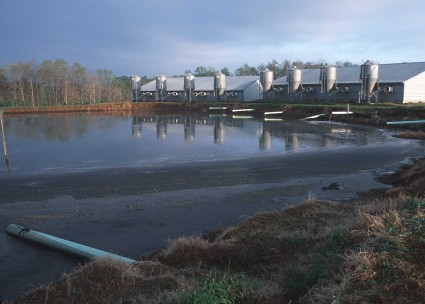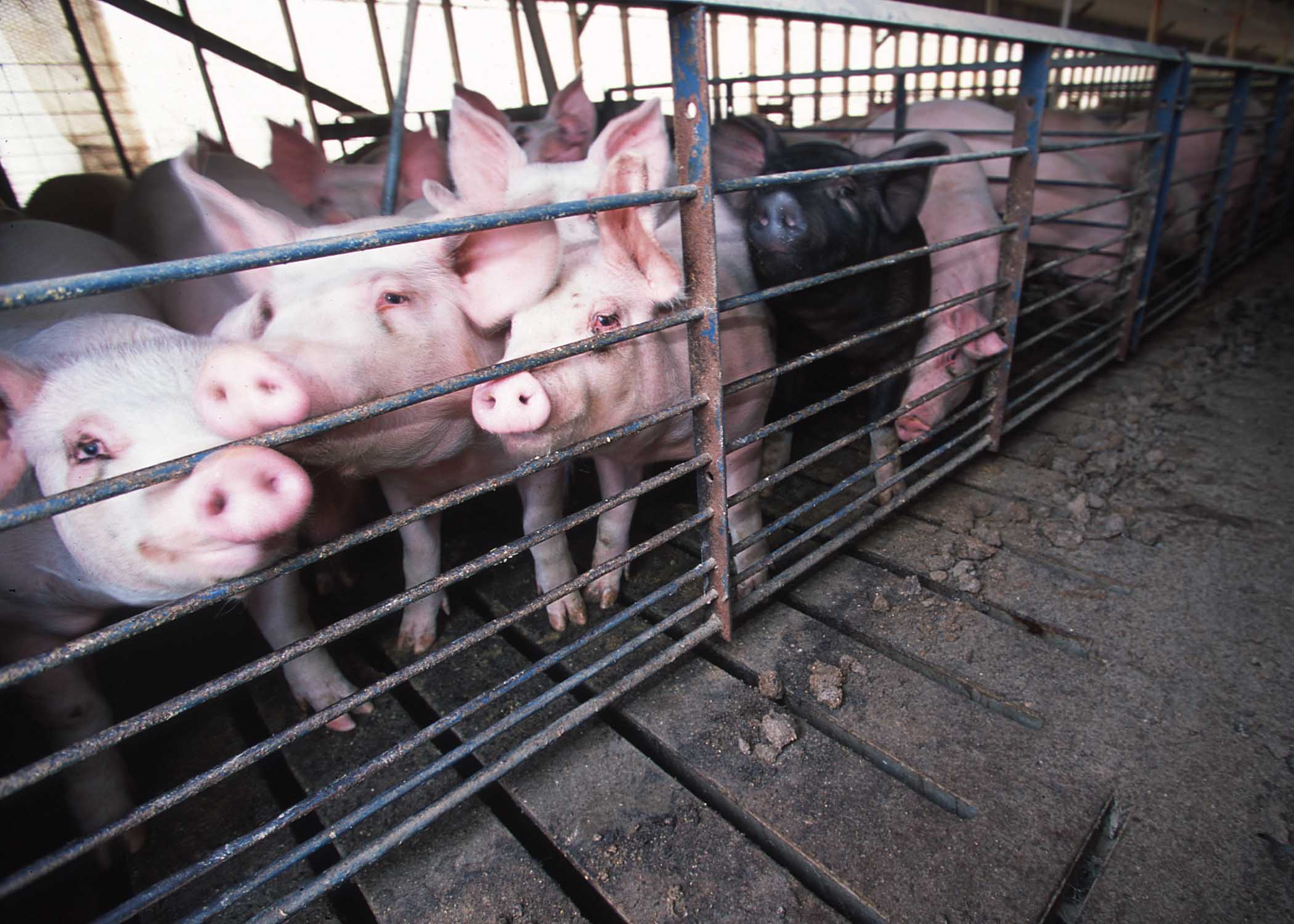 Not hogging the H1N1 spotlight: A “state of the art” pig CAFO in Georgia.Photo courtesy of USDA Natural Resources Conservation Service.“When respiratory viruses get into these confinement facilities, they have continual opportunity to replicate, mutate, reassort, and recombine into novel strains … The best surrogates we can find in the human population are prisons, military bases, ships, or schools. But respiratory viruses can run quickly through these [human] populations and then burn out, whereas in CAFOs — which often have continual introductions of [unexposed] animals — there’s a much greater potential for the viruses to spread and become endemic.”
Not hogging the H1N1 spotlight: A “state of the art” pig CAFO in Georgia.Photo courtesy of USDA Natural Resources Conservation Service.“When respiratory viruses get into these confinement facilities, they have continual opportunity to replicate, mutate, reassort, and recombine into novel strains … The best surrogates we can find in the human population are prisons, military bases, ships, or schools. But respiratory viruses can run quickly through these [human] populations and then burn out, whereas in CAFOs — which often have continual introductions of [unexposed] animals — there’s a much greater potential for the viruses to spread and become endemic.”
— Gregory Gray, director of the Center for Emerging Infectious Diseases at the University of Iowa College of Public Health, quoted in “Swine CAFOs & Novel H1N1 Viruses,” Environmental Health Perspectives, September 2009, by Charles W. Schmidt.
——————-
Almost exactly six months ago, I caused a stir by suggesting a possible link between CAFOs and the new strain of H1N1 swine flu that had just broken out. (See here and here.)
My position generated a certain amount of outrage, even among some commentators not linked to the meat industry. How dare I point to a possible link based on indirect, circumstantial, evidence?
Half a year later, I would love to be able to review results of a rigorous set of tests on CAFOs. I wish I could report that USDA researchers had been showing up on hog confinements and taking swabs; that CAFO workers were being monitored for H1N1 infections or antibodies; that the EPA was looking hard at CAFO cesspools — known as lagoons — to see if they could be possible vectors of infection.
From what I can tell, though, none of that is happening — even with the novel H1N1 virus spreading rapidly and vaccines still in short supply.
Check out this jaw-dropping Washington Post article from last weekend. Reporter David Brown buried his lead — more on that below — but here’s the bombshell:
The search for influenza in pigs [on CAFOs] has actually decreased in the six months since the H1N1 strain was discovered in California and Mexico in April. Diagnostic labs in Minnesota, Kansas and Iowa report a decline in samples submitted by veterinarians; the lab at Iowa State University recently eliminated three positions because of “decreases in overall case revenue.” [Emphasis added.]
Did you get that? Since the global flu pandemic broke out, testing of pigs for H1N1 has dropped. Why? Here’s the Post:
Most American pig farmers — who have been losing money since the fourth quarter of 2007 — don’t want to know whether the new strain is in their herds. … “People are really scared if their farm is the first one to find an outbreak of pandemic H1N1,” said … [a] Kansas State microbiologist. “They are afraid they will lose their livelihood.”
 A “state of the art” cesspool at a hog confinement in Georgia. “The facility is completely automated and temperature controlled,” the NRCS reports. Photo courtesy of USDA Natural Resources Conservation Service.Okay, so no individual hog grower has an interest in knowing whether a particular confinement house is incubating novel strains of swine flu. I can understand that. As I’ve written before, the industry is hyper-consolidated; four companies slaughter and process 65 percent of the hogs raised in the United States. Farmers operate under such tight profit margins — and often, as now, negative profit margins — that swine flu becomes just another threat to their fragile livelihoods.
A “state of the art” cesspool at a hog confinement in Georgia. “The facility is completely automated and temperature controlled,” the NRCS reports. Photo courtesy of USDA Natural Resources Conservation Service.Okay, so no individual hog grower has an interest in knowing whether a particular confinement house is incubating novel strains of swine flu. I can understand that. As I’ve written before, the industry is hyper-consolidated; four companies slaughter and process 65 percent of the hogs raised in the United States. Farmers operate under such tight profit margins — and often, as now, negative profit margins — that swine flu becomes just another threat to their fragile livelihoods.
Thus we’ve got a gaping market failure on our hands; the industry has demonstrated its inability to regulate itself on this issue.
Given the vast public-health threat, one might expect the government to step in and perform tests. Is it happening? Stunningly, no. All the USDA has done is to create a voluntary program — which, as noted above, no hog grower has an interest in using.
Well, if no one’s testing the hogs, someone must be testing the workers, right? You know, the people who come into contact with the hogs daily, breathe in air full of their fecal particles and breath exhalations, and then head into the surrounding community?
Wrong again. In fact, the government has thus far even declined to make CAFO workers a “priority group” for H1N1 vaccines, the Post reports.
Well, maybe I’m being alarmist. Maybe there’s no rational reason to suspect that the practice of confining thousands of animals into buildings over their own waste gives novel viruses a wonderful habitat in which to flow from host to host, mutate, and jump species to humans. Maybe the industry’s much ballyhooed safety efforts, in which hog confinements are treated like biosecurity time bombs, are successfully keeping pigs and the workers who watch over them from swapping virus strains.
But that’s simply not the case, according to the Post piece. Are CAFO conditions keeping swine free of swine flu? No. “A survey done in 2006 found that 58 percent of pig farms had at least one animal with antibodies to influenza,” the Post reports. Moreover, there have been several instances of swine herds testing positive for the current novel strain. For example:
Scientists at the University of Minnesota and the University of Iowa revealed last week they had identified the H1N1 strain in seven pigs at the Minnesota State Fair in late summer as part of a study of virus exchange between swine and people. Some of those animals may have caught the bug from the hordes of visitors at the 12-day event. But not all: One infected animal was swabbed while being unloaded and almost certainly arrived with the virus.
Now, let’s think about this. These were randomly selected animals tested as part of a study, and not obviously sick ones a farmer brought in for testing. If a random study picked up novel H1N1 among CAFO pigs, how many more out there, among the 20 million-strong U.S. swine herd, also have it?
Well, perhaps CAFO conditions aren’t actually conducive to the generation of new strains. Wrong again. The Post:
[I]f multiple flu viruses were to get into a CAFO, the crowding of the animals would make widespread transmission, and the chance of reassortment, likely. Mathematical modeling suggests CAFOs can function as “amplifiers” of pandemic strains.
Oh dear. Well, maybe the factory style of hog rearing creates a barrier between infected swine and their human handlers. But again, no. Here’s the Post:
In 2006, a team of researchers at the University of Iowa examined blood samples from 111 [hog] farmers, 65 veterinarians and 97 meat-processing workers, and compared them with 79 university employees and students who had no contact with pigs. The scientists looked for antibodies to two common swine influenza viruses. They found that 17 to 20 percent of farmers and 11 to 19 percent of veterinarians had evidence of previous infection by the two strains. None of the meatpackers or students did.
And those who do pick up swine flu from the swine they have contact with are fully capable of passing it on. “Another study by the same research team found that the wives of half of infected pig farmers had the antibodies — suggesting that person-to-person transmission of the viruses was possible,” The Post adds.
So, amid the scramble to mass-produce a vaccine, factory swine farms are indisputably a major possible source of novel viruses — and there’s virtually no organized effort to scrutinize them. The best analogy I can think of is this: A town full of suspected arsonists with access to gasoline and matches has an outbreak of mysterious fires. In response, the town dismisses its cops and beefs up its fire department.
The question becomes, why is the government failing so willfully to investigate the possible link between CAFOs and the outbreak of a novel swine flu? I think we can find a clue in the very Washington Post article under discussion. For all the important and damning information contained in it, it opens on a CAFO, which it describes as a paragon of biosafety.
It may be crowded and carpeted in manure, but the long, white building beside State Route 38 is one of the most pathogen-free homes a pig could have.
Really? Several paragraphs later, we get this: “CAFOs such as Schott’s are inherently safer than backyard pig farms, where the animals mingle with people and birds fly overhead.” In an otherwise lavishly sourced article, there’s absolutely no scientific evidence presented to back up this claim.
My thesis is this: the pork industry is so powerful and entrenched that the Post didn’t dare publish such an explosive article without these spurious hedges about the “inherent” safety of CAFOs.
And the same factor has the federal government scrambling to put out fires, while willfully ignoring a key arson suspect.
My guess is that the CAFO system would not survive a rigorous public-health assessment. If federal authorities began to seriously examine the risk-reward balance between cheap pork and novel flu pandemics, cheap industrial pork would start to look like a pretty trivial reward. But that would lead to the collapse of a multi-billion dollar industry — and a bitter fight with the corporate giants — Cargill, Smithfield, and Tyson — that dominate the pork trade.
From the start of the outbreak, USDA chief Tom Vilsack has cravenly leapt to the defense of the swine industry. Check out this Wall Street Journal article from May — the early days of the crisis.
While Agriculture Secretary Tom Vilsack says there is “no evidence” of the new swine flu in U.S. pigs, the federal government doesn’t aggressively search for it on farms.
Mr. Vilsack’s statement is designed to bolster the Obama administration’s argument that U.S. consumers and trading partners haven’t any reason to shy away from eating U.S. pork. But the observation isn’t based on any extensive sampling program of the sort that is used by the federal government to alert it to other animal diseases, such as mad-cow disease and bird flu.
Indeed, only in recent months has the Agriculture Department begun organizing a federal pilot program for screening pigs for flu. And that move came at the prodding of officials at the U.S. Centers for Disease Control and Prevention. CDC officials have been worried that pigs might serve as a “mixing vessel” for a flu virus capable of sweeping through the human population. The pilot program has yet to begin to collect samples. [Emphasis added.]
Well, as novel swine flu continues its rapid spread, things have evidently changed little with regard to the USDA’s zeal to track down the source of swine flu.
If the Post article opens with a bow to the pork industry, it closes on a chilling note:
Most of the flu viruses already in American pigs contain genes derived from human, pig and bird strains. Such mongrelized viruses, scientists believe, are more likely than others to reassort again, setting the stage for another pandemic.
And the place they’ll likely do it, it seems reasonably clear, is within CAFOs.




